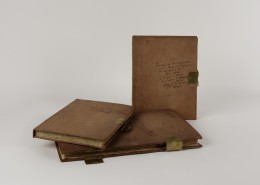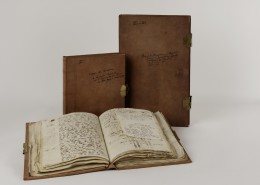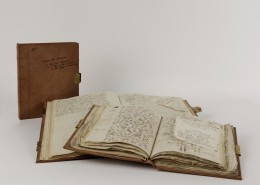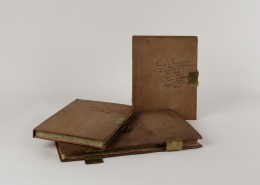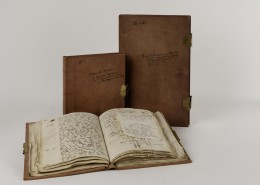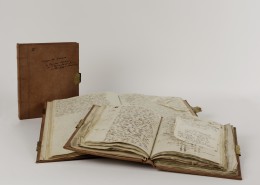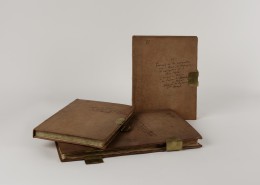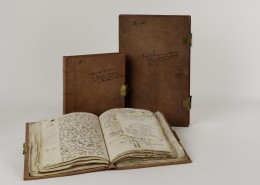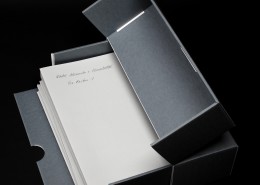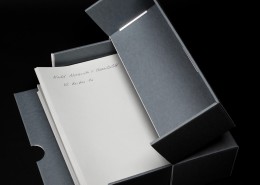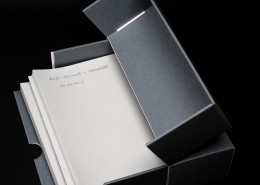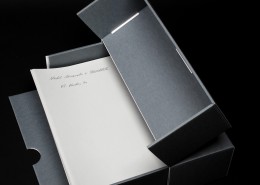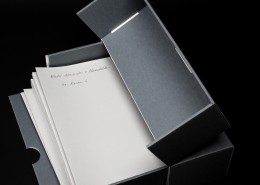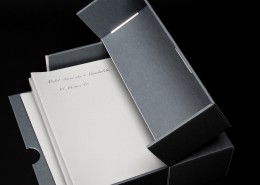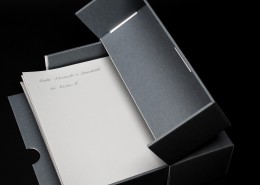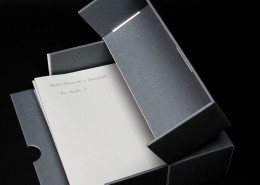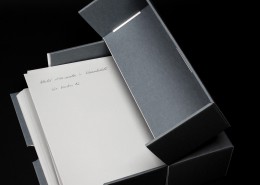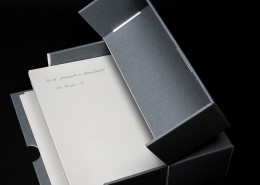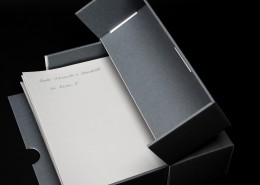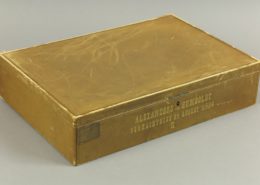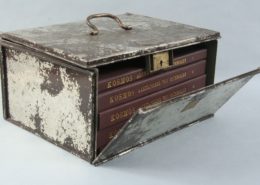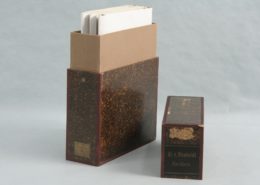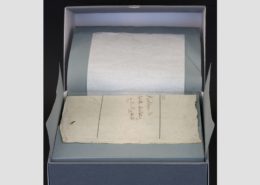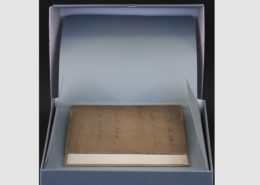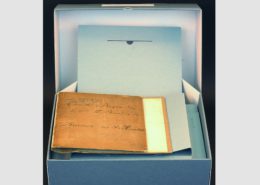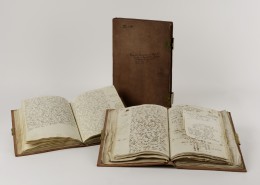
Work
Alexander von Humboldt’s American travel journals
The American travel journals of Alexander von Humboldt (1769-1859) are some of the most important documents in the history of science and of travel literature, and some of the politically and socially most important texts of the late eighteenth century and nineteenth century. They are based on Humboldt’s five-year journey through the American tropics between 1799 and 1804, together with the Frenchman Aimé Bonpland.
The travel journals mark a definitive paradigm shift in scientific and cultural studies towards a temporal and historical conception of all knowledge in the context of the foundational days of modern Europe.
If you would like information on the content of the individual journals and direct links to the related entry in the Kalliope Union Catalogue and in the Digitized Collections of the Berlin State Library, click on the appropriate image below.
Form and content of the American travel journals
It seems to have been only a year before his death that Humboldt had his travel manuscripts, notebooks and worksheets put together to form today’s nine pigskin-bound, highly heterogeneous volumes. Additionally, at his personal behest, these tomes include his travel records and research notes relating to various expeditions throughout Europe which he undertook before and directly after his journey through the Americas.
All volumes exhibit the typical characteristics of Humboldt’s travel journals: the texts are often not written in chronological order; moreover, a few precisely dated passages on daily events alternate with general notes. Humboldt writes in German and French, although occasionally also in Spanish. It is evident that Humboldt used the journals as tools for research and banks of knowledge until his death: they are marked by insertions, deletions, explanatory notes, quotations – in short, all conceivable annotations from the entire time of his work as a scientist. Numerous pages are known to have been cut out, only some of which are known with certainty to have been included in his personal papers. It is not yet definitively certain when and why these extractions were made. The journals contain two numbering systems in their modern version: page numbering (pagination) made mainly by Humboldt in ink, and the supplementary sheet numeration (folio numbering) made in pencil at the Moscow Lenin Library (foliation). The Russian numbering is the system widely used in research, since it is complete and comprises all loose pages, as well as those glued in by Humboldt.
History of ownership of the American travel journals
Humboldt determined in his will that his journals and personal papers should be made available to science. Despite him bequeathing his papers to the Royal Library, the journals remained in the possession of Wilhelm von Humboldt’s descendants. While the papers were evacuated from the Prussian State Library in Berlin to Silesia during the Second World War, the journals were carried from Tegel Palace to the Soviet Union towards the end of hostilities. There they were housed at the Moscow Lenin Library and were returned to the German Democratic Republic in 1958, along with numerous other holdings from the Prussian State Library that had been relocated to Moscow. After the Reunification the von Heinz family deposited the journals in the Berlin State Library – Prussian Cultural Heritage. In 2005 the family recalled the collection deposit, but in 2013 the Prussian Cultural Heritage Foundation was able to acquire the journals for the Berlin State Library with funding from numerous public and private donors, in the sum of 12 million Euros. The portion of Humboldt’s estate evacuated to Silesia is currently housed in the Jagiellonian Library in Cracow.
Research and edition of the American travel journals
With a fresh perspective and an innovative approach, the “Alexander von Humboldt’s American travel journals”, project of the Berlin State Library together with the University of Potsdam, financed by the German Federal Ministry of Education and Research, aims to place the American travel journals in the context of the culture, politics, society and research of the 19th century. To this end, along with the American travel journals the project is also opening up and digitising the personal papers of Alexander von Humboldt held in the Berlin State Library and the Jagiellonian Library in Cracow, thus making them available to the public in their entirety. In the Potsdam research project, the journals are currently being researched by a team of five early career scientists and academics, under the direction of Ottmar Ette, from multiple perspectives: literary history and theory, image analysis, epistemology, and space and motion theory.
“Travelling Humboldt – Science on the Move” has been adopted as a project by the Berlin-Brandenburg Academy of Sciences (Berlin-Brandenburgische Akademie der Wissenschaften) into its programme for 2015. At the interdisciplinary meeting point between cultural studies and the natural sciences, this project aims to produce a complete edition of all of Alexander von Humboldt’s travel-related manuscripts (travel journals, diaries, memoranda, memoirs, publications in the countries and regions travelled, correspondence), in keeping with the tradition of Humboldt’s own research at the Berlin-Brandenburg Academy of Sciences.
Alexander von Humboldt’s personal papers in Berlin
Alexander von Humboldt’s personal papers consist of large and small boxes. These boxes contain both his “real” papers – also referred to as the “Collectanea” – as well as his letters – the “Humboldtiana”. Besides the “Darmstaedter Document Collection”of the Berlin State Library also possesses letters written to Humboldt by 546 different individuals.
If you would like information on the content of the individual boxes and direct links to the related entry in the Kalliope Union Catalogue and in the Digitized Collections of the Berlin State Library, click on the appropriate image below.
"Collectanea on Cosmos"
All boxes of the “Collectanea on Cosmos” (“Kolektaneen zum Kosmos”), were stored in the observatory in Babelsberg until 1932. According to Humboldt’s will they had to be transferred to this place after his death and be available for further research. In 1932 the descendants of Humboldt donated all boxes to the Prussian State Library. These were the large boxes 1, 2, 4, 5, 6, 8, 9, 11, 12, 13 and 14. Humboldt had bequeathed box 10, which is missing in the numeration, to his secretary Eduard Buschmann. Together with his personal papers, its contents came to the Royal Library in 1883; there, however, it was assigned to that part of Humboldt’s personal papers which today is preserved in the Jagiellonian Library in Cracow (see below). Only after their arrival at the library, the boxes 3 and 7 and 14 were called small boxes and now have the numbers 3a and 3b, 7a and 7b, and 14, respectively.
Humboldtiana in the Darmstaedter Document Collection
The State Library added three small boxes (1a and 1b, 2) the so-called “Humboldtiana”, which mainly contain letters and copies of letters from and to Humboldt. The library acquired these letters from different previous owners at various times between 1912 and 1936.
Letters addressed to Humboldt in the Darmstaedter Document Collection
In the years 1927 and 1928, the Friends of the Prussian State Library (Verein der Freunde der Preußischen Staatsbibliothek) donated to the library letters of 546 persons, all of them addressed to Alexander von Humboldt. The letters were included in the Darmstaedter Document Collection of the library and assigned to the relevant scientific disciplines, which form the structure of the collection.
You can find a comprehensive presentation of the history of Humboldt’s personal papers in the article „Nachlassgeschichten – Bemerkungen zu Humboldts nachgelassenen Papieren in der Berliner Staatsbibliothek und der Biblioteka Jagiellońska Krakau“ (published in HiN XVI, 31 (2015)).
Alexander von Humboldt’s collected papers in Cracow
The part of Humboldt’s personal papers which had been evacuated to Silesia during World War II is today preserved in the Jagiellonian Library in Cracow. Besides the collectanea on Cosmos held by the State Library Berlin – Prussian Cultural Heritage Foundation it is the second large collection on Alexander von Humboldt. The material came to the library in several portions and comprises manuscripts, sketches, and galley proofs of numerous published and also unpublished texts. The collection comes from the bequest of Humboldt and was largely complemented by Eduard Buschmann‘s Humboldt collection. Buschmann, who had made the majority of copies of the late works of Humboldt – in the first place Cosmos –, was donated parts of the collection already during his lifetime. After Humboldt‘s death Buschmann inherited other parts, as for example the collections of material on the ‘Examen critique’. The collection also includes two large correpondences – with Eduard Buschmann and the Potsdam cartographer Heinrich Berghaus.
If you would like information on the content of the individual volumes and direct links to the related entry in the Kalliope Union Catalogue and in the Jagiellonian Digital Library Cracow, click on the appropriate image below.
Volumes 1-4b
The first volumes of the holdings held in Cracow under the title “Nachlass Alexander von Humboldt” consist of acquisitions which came to the Berlin Royal Library as early as 1868. Volumes 1-4b contain Humboldt’s papers on statistics of Mexico and Cuba as well as a Memoire of Albert Gallatin on the indigenous people of North America.
Volumes 5-14 (Eduard Buschmann)
The other parts come from the Humboldt collection of Eduard Buschmann, which came to the Royal Library in two portions: Volume 5 with the manuscripts of Cosmos as a donation in 1870, and Volumes 6-14, in an unexplained way, from the Berlin University Library in 1894. Volumes 6-14 contain, besides numerous drafts and materials on the history of the discovery of the New World and other papers, including the correspondence betweeen Humboldt and Buschmann.
Volume 15
The last volume with the number 15 was originally shelved separately under the shelfmark ms. germ. qu. 1031 and later became part of the collection. As a result of wartime events, the valuable collection was evacuated from Berlin to Silesia in 1941. After the end of the war, the collection came to the Jagiellonian Library, where it has been preserved since.
You can find a comprehensive presentation of the history of Humboldt’s personal papers in the article „Nachlassgeschichten – Bemerkungen zu Humboldts nachgelassenen Papieren in der Berliner Staatsbibliothek und der Biblioteka Jagiellońska Krakau“ (published in HiN XVI, 31 (2015)).

